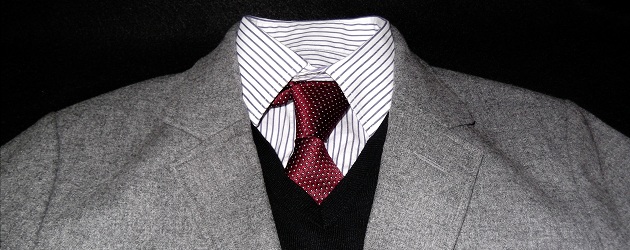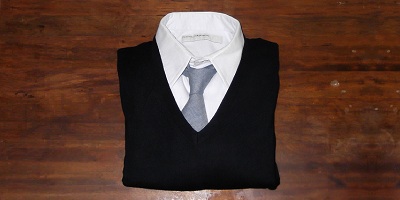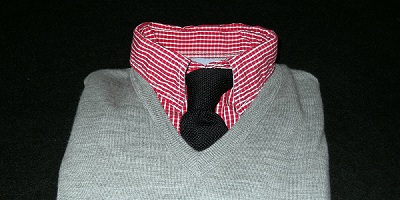Knowing how to layer is a little like learning to speak another language. At some point you become fluent* and you stop carefully assembling your sartorial sentences piece by piece. Your closet blurts out a combination, and you know it looks good.
Even if you’ve been layering with ease for awhile, it’s always good to keep these guidelines in the back of your mind. And despite the use of the word “rules” up in the title, there are exceptions for everything. Trust your own eyes and your gut, but when in doubt, these rules for layering should keep your look on the safe but still sharp side.
.
#1. Contrast is key when it comes to colors & patterns.
You can wear blue on blue on blue, but those blues better be at least a couple of shades different. You can wear patterns on top of each other, but small check on small stripe is tough to pull off. This all comes down to how easy it is for a viewer’s eyes to decipher where your sweater starts and where your shirt ends. If the colors and patterns are all too close the eye has to work harder and you’ll run into trouble.
#2. Textures matter. The rougher it gets, the less of that fabric you can wear.
This is similar to the color & pattern contrast rule. A rough tweed jacket over a crewneck lambswool sweater over a corduroy shirt will leave you looking like an enormous ball of fuzz. Yet a cotton chino blazer over a smooth cotton/cashmere blend sweater over a poplin shirt still works. The more noticeable the texture the less of that kind of thing you can stack on top of each other. Unless you’re going for the lumberjack look. Shown above: Three distinct textures. Moleskin, Lambswool, and Poplin.
#3. Dress like a Thanksgiving meal. You need a dependable main course.
Your outermost layer is almost always going to be the turkey. You need an anchor, albeit an awesome one, for your combinations. It’s the smaller things (like the yams & salads on Thanksgiving) that you can experiment with. Ties, shirt patterns under sweaters, etc. are where to take risks. See above. Imagine if the shirt was grey and the sweater was red checked. A little rough on the eyes, right? Bottom line, in terms of the Thanksgiving analogy? Screw with the bird and you end up with a Cosby sweater.
.
Final Notes:
Shading – It’s usually easiest to start with your lightest color on the bottom and work your way up. That’s one of the many reasons why almost everyone looks great in a bright white button up shirt.
The slow build: Don’t jump ahead – There’s a method to layering madness. It’s supposed to be functional. That means thin & light stuff on the bottom, medium in the middle, then thick stuff on top. Skip more than a few layers and it looks too trendy, i.e. t-shirt under blazer.
The Trouble with Marled – Remember, marled fabrics are like patterns. A marled blazer over a marled sweater is really risky. Chances are it won’t work.
Outerwear counts – This is why most coats and jackets are solids. Because they’re going to be your top most layer. A black or navy double breasted mid thigh length peacoat is a can’t miss for winter.
The Fail safe Layered Look – White based cotton poplin or oxford underneath. Medium shade / subtle color merino wool V-neck over that. Finish it off with a darker sportcoat or blazer.



